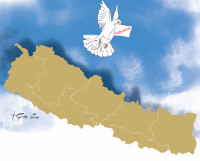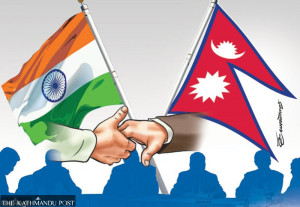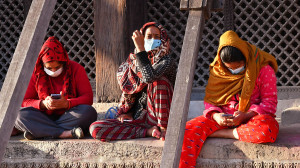Columns
Reimagining development funding
Despite issues of efficiency with NGOs, their grassroots presence is still essential.
Dr Bhagwan Koirala & Dr Pukar Malla
The paradigm of dependency on external donors for financing global development is undergoing rapid change. From the political consequences of cancelling USAID to a nation’s graduation from the Least Developed Country (LDC) status in November 2026, the streams of Official Development Assistance (ODA) are drying up. For instance, the United Kingdom’s Foreign, Commonwealth & Development Office is phasing down aid from 0.7 percent of the country’s Gross National Index (GNI) in 2020 to a projected 0.3 percent by 2027. The more than $500 million reduction of United States aid, including the new $659 million five-year commitment cut, has lowered the morale and opportunity of hundreds of actively working non-profits. As global aid reductions persist, the repercussions will only intensify further.
In this rapidly evolving global and national context, if Nepal’s non-profit sector is to continue serving as a vital vehicle for inclusive development, it must transition from an external donor-driven model to a resilient, self-sustaining model rooted in strategic partnerships and outcome-oriented financing.
The shift to be made here is accepting cross-sector collaboration between nonprofits and government, the private sector and the largely untapped diaspora. The architecture must rest on three interlocking pillars: Increased domestic fund mobilisation, strategic deployment of local competencies and greater cost-effectiveness. These principles, when combined, can help Nepal’s non-profit sector become less reliant on external funding and enable it to innovate, adapt, and thrive independently.
Utilising strategic budget allocation
The underutilisation of the development budget is a persistent issue Nepal faces, exacerbating the inefficiencies of public financing. Last fiscal year, the three layers of government spent only 66 percent of the allocated Rs1.8 trillion, highlighting a persistent trend of chronic underspending which has averaged 35.3 percent over the last nine years. The World Bank has cited opaque supply-driven project selection as the primary cause of this trend. Project selection is based on untested supply instead of actual demand, resulting in poor project selection and a lack of proper feasibility studies. These factors lead to underspent funding, cost overruns and significant delays.
Rather than allowing these unspent funds to remain idle, Nepal can reorient public financing. The country can redirect public spending to community health, rural entrepreneurship and public education, utilising performance-based grants or co-financing partnerships with qualified non-profits. Strategic budget allocation and spending can unlock significant development achievements and bolster self-reliant domestic financial resilience.
While NGOs have proven to have a stronger capacity to identify grassroots needs and enable community-level participation, government agencies often view NGOs as donor-aligned service providers rather than long-term, service-innovating strategic partners. This perception must shift with the government institutionalising public and social sector partnership with a framework that ensures mutual accountability, trust and efficiency, reducing bureaucratic friction and maximising impact.
In addition, the streamlined and transparent channelling of funds will ensure that fair and community-result-oriented government spending translates to sustainable social change. However, governance issues, especially concerning accountability, financial and managerial performance, remain significant obstacles. Nonprofits can access government funding more efficiently if there is a strong public sector reform risk monitoring and evaluation system in place.
CSR contributions to nonprofits
For the financing process to be sustainable, private companies play a vital role, and this could be one untapped opportunity in this period of crisis. The possible avenues where the NGOs and private organisations interact could upgrade from the existing awareness raising and information sharing to resource contributions and resource pooling. Amongst the resource contributions, CSR, in particular, remains misunderstood and underutilised. It is often seen merely as a form of afterthought philanthropy, manifesting as haphazard, short-term, unmanaged and relationship-based donations; rather than being recognised as a strategic and systemic tool for sustainable development.
Nepal’s IEA and NRB directives mandate companies to devote a portion of their CSR budget to chronic, deep-rooted challenges of the society, but more often than not, such funding is used as corporate visibility campaigns.
In the fiscal year 2019-20, Banks and Financial Institutions (BFIs) allocated 1.58 percent of their net profits to CSR initiatives, amassing Rs1.28 billion. However, these distributions fail to align with measurable development milestones. In the absence of standardised impact assessment frameworks, CSR initiatives tend to be optional and lack independent scrutiny. Without standard frameworks for social impact assessment or designated oversight bodies, the potential for transformation is sharply limited.
Integrating the strategic imperatives of local healthcare access, quality education, entrepreneurship and institutional capacity-building within governance frameworks into healthcare can multiply the impact of CSR funds. Broader and more detailed ethical impact dashboards that publicly monitor the distribution of CSR funds alongside social returns on investment will bolster transparency and responsibility. Strengthened governance structures would shift CSR from superficial, compliance-driven exercises to a fundamentally repositioned responsive engine for social initiatives that weave together the heft of private investments and the nimbleness of the nonprofit sector.
Philanthropic foundations and their models
While Nepal’s philanthropic industry has made strides towards social development, its predominant charity-centred approach often focuses on short-term, immediate relief instead of long-term sustainability.
To achieve meaningful community impact, there is a greater need to adopt systematic evaluation frameworks that move enduring impact beyond annual cycles. Lessons from other philanthropic models could aid in foundation-led initiatives in Nepal. The Gates, Ford and Rockefeller Foundations, for example, prioritise building capacity, strengthening systems and giving grantees the freedom to lead with local innovation. In Nepal, foundations are trying to shift towards more ecosystem-building approaches, a step in the right direction.
Moving towards that approach, instead of starting their initiatives, they should focus on robust support for established, innovative and results-driven organisations. This can be achieved through strategic investing in capacity-building grants, co-financing targeted sector impact funds to curtail redundancy and promoting accountability through shared evaluation frameworks and independent third-party tracking.
Crowdfunding and diaspora investment
Since personal remittances constitute roughly 25 percent of Nepal’s GDP, the diaspora can sustain NGO funding beyond traditional models. These individuals are reminders of the extensive connections and increasing wealth that are probably not driven by political interests, while interwoven with the nation. For NGOs to communicate their results through impact stories, social capital must be restored. It equally falls upon the SWC, which must create processes for demonstrating inter-NGO, outcome-based accountability to close the gap between diaspora funding intentions and NGO responsive actions.
To institutionalise these funding mechanisms, Nepal could develop a government-verified crowdfunding portal, consolidating project listings, enforcing due diligence and integrating real-time impact dashboards. Like international crowdfunding successes, diaspora bonds with competitive yields and transparent governance could also raise millions annually if coupled with strategic promotional efforts through embassies and global networks. Over time, these tools would complement crowdfunding platforms, fostering a self-reliant financing ecosystem that amplifies local ownership and sustainable development.
Conclusion
Despite issues of efficiency with NGOs, their grassroots presence is still essential. Government leadership is key to optimising resources and formalising the discussed mechanisms that ensure accountability and impact. Credibility must be built through government-verified platforms, transparent fund flows, independent audits and standardised reporting to strengthen internal crowdfunding models. These safeguards can be institutionalised; the aforementioned mechanisms will prove to be a trusted pillar of Nepal’s development financing.




 19.12°C Kathmandu
19.12°C Kathmandu

.jpg&w=200&height=120)












%20(1).jpg&w=300&height=200)

